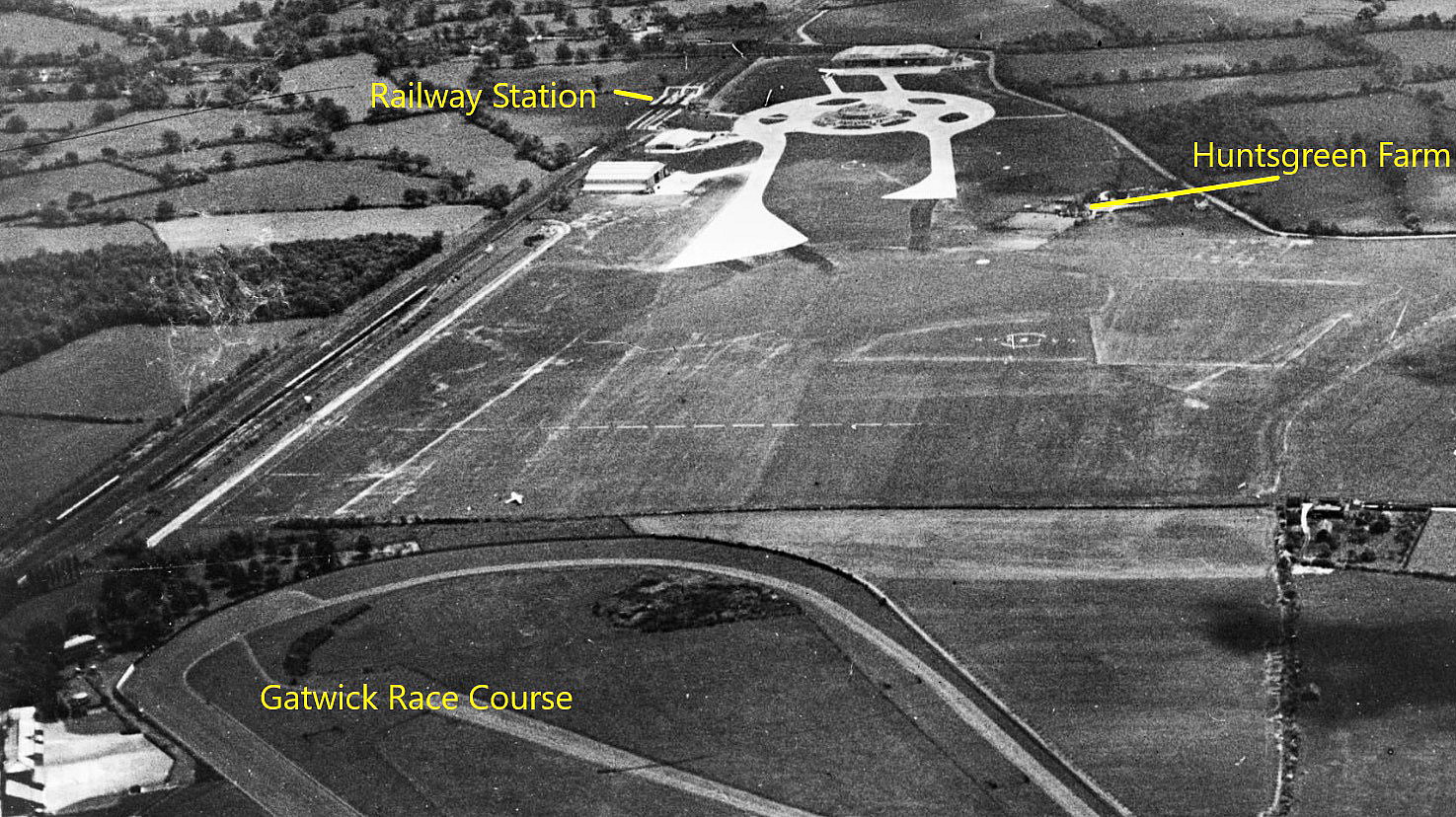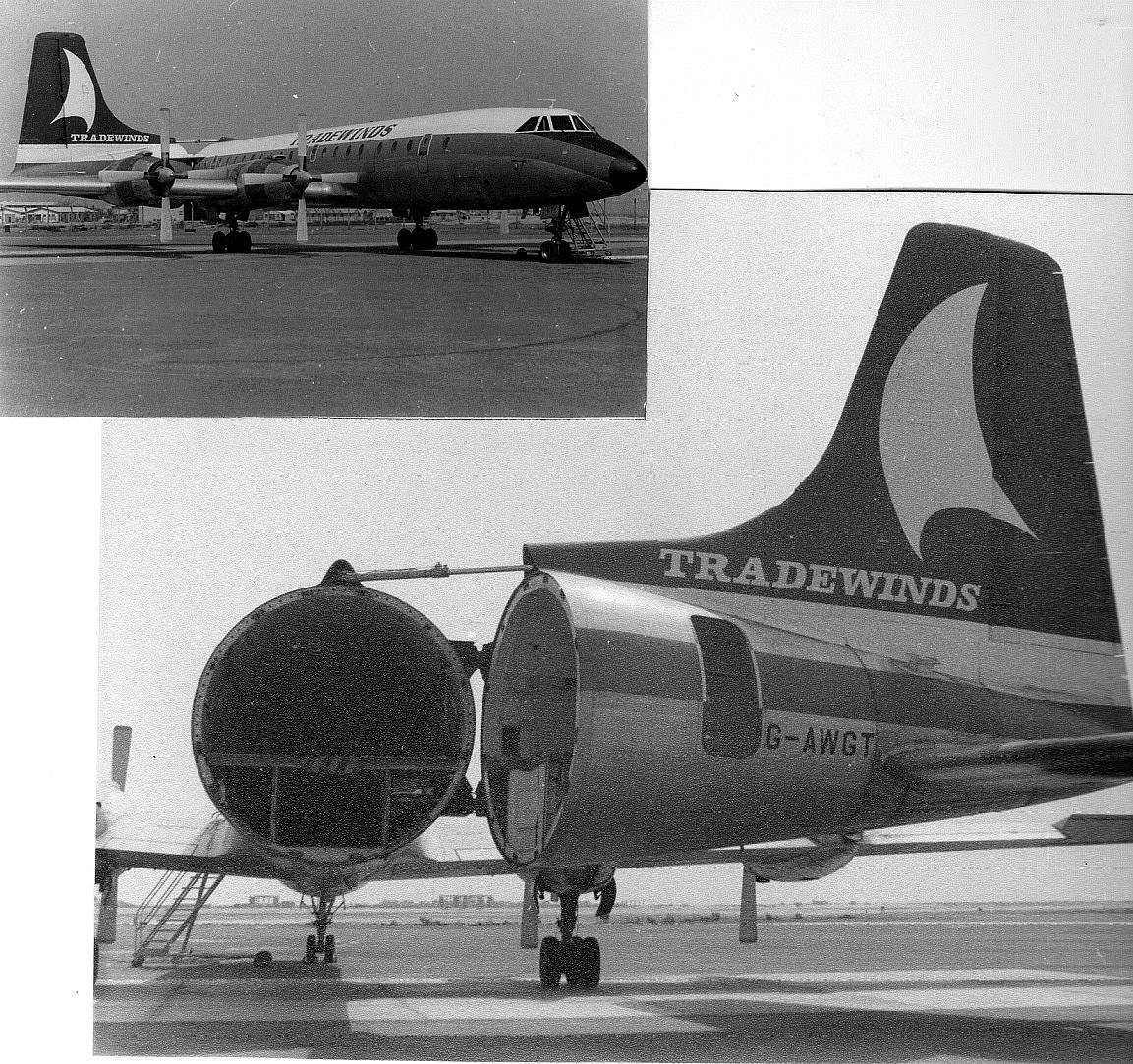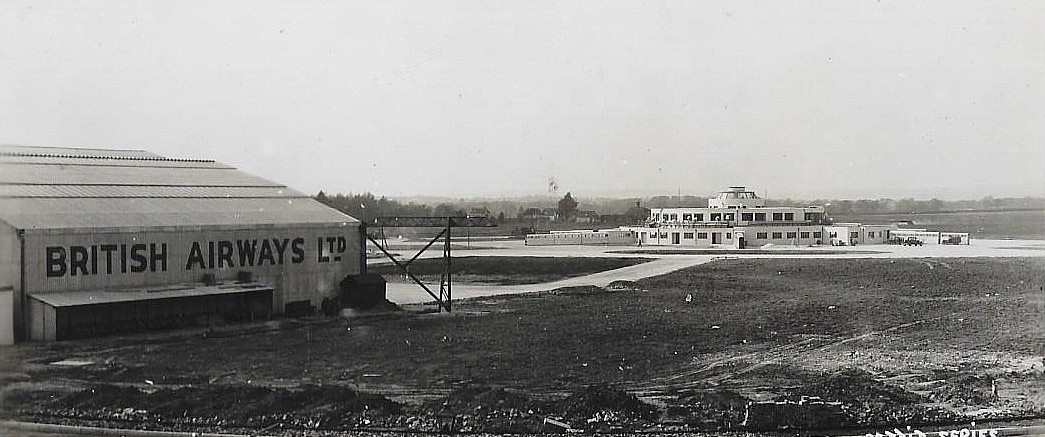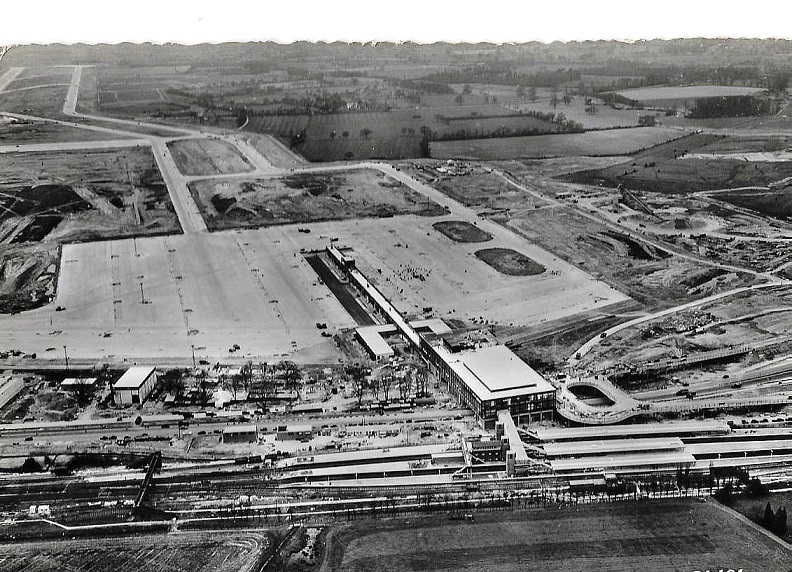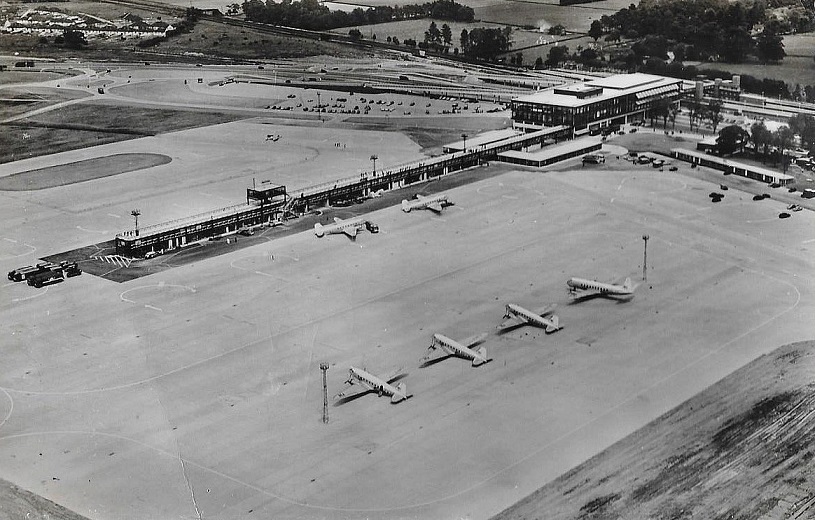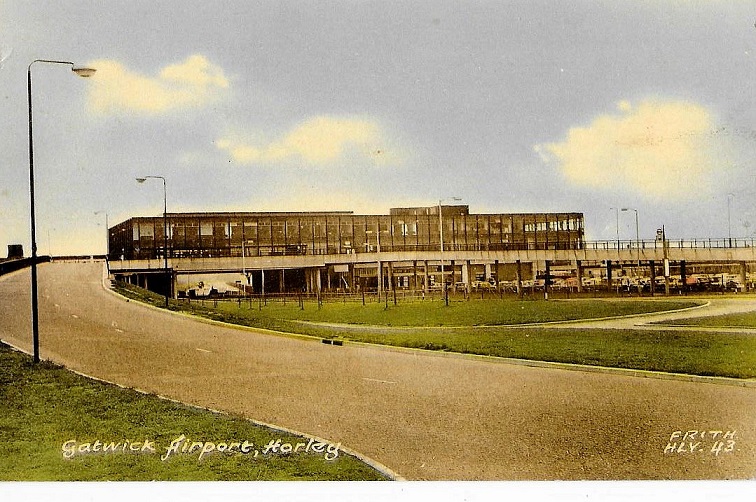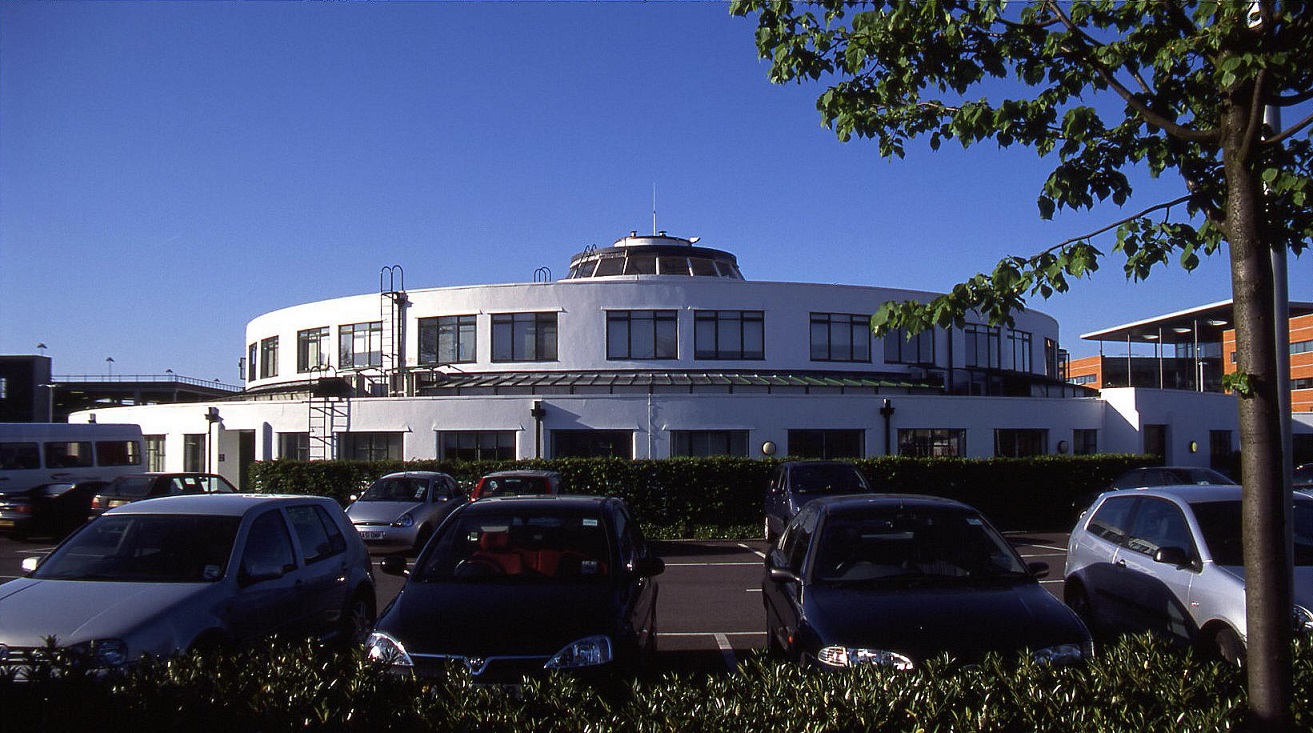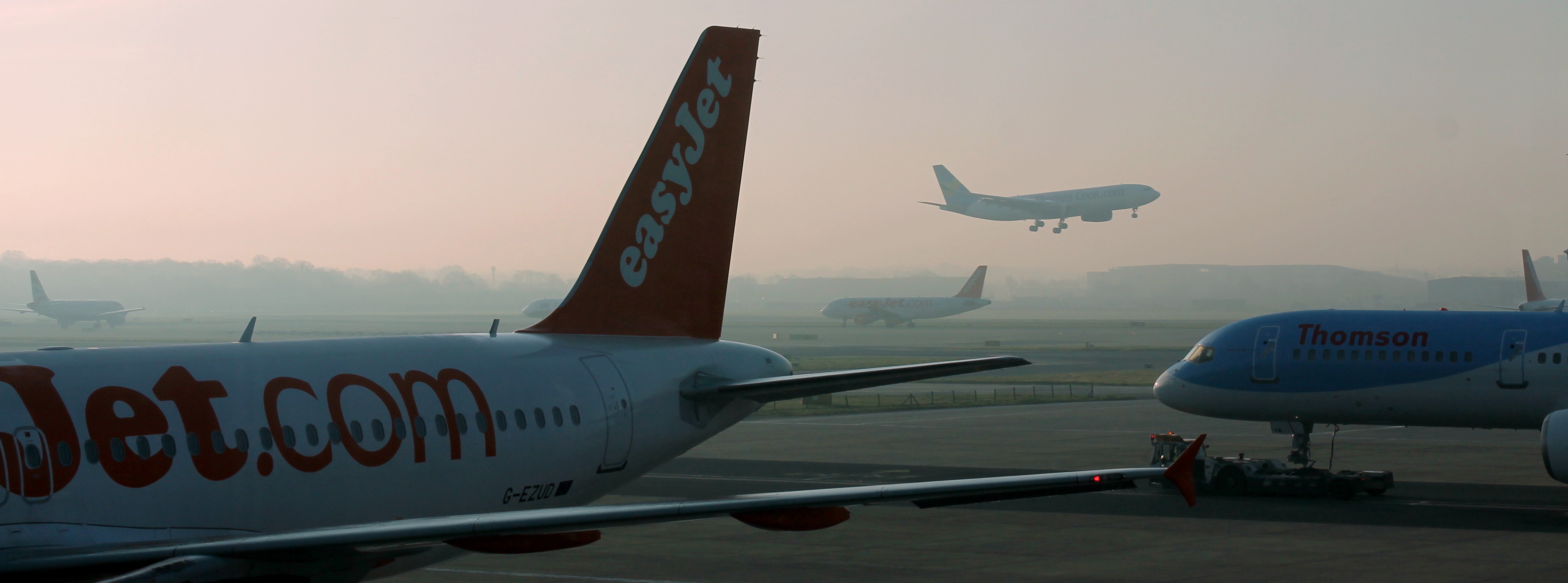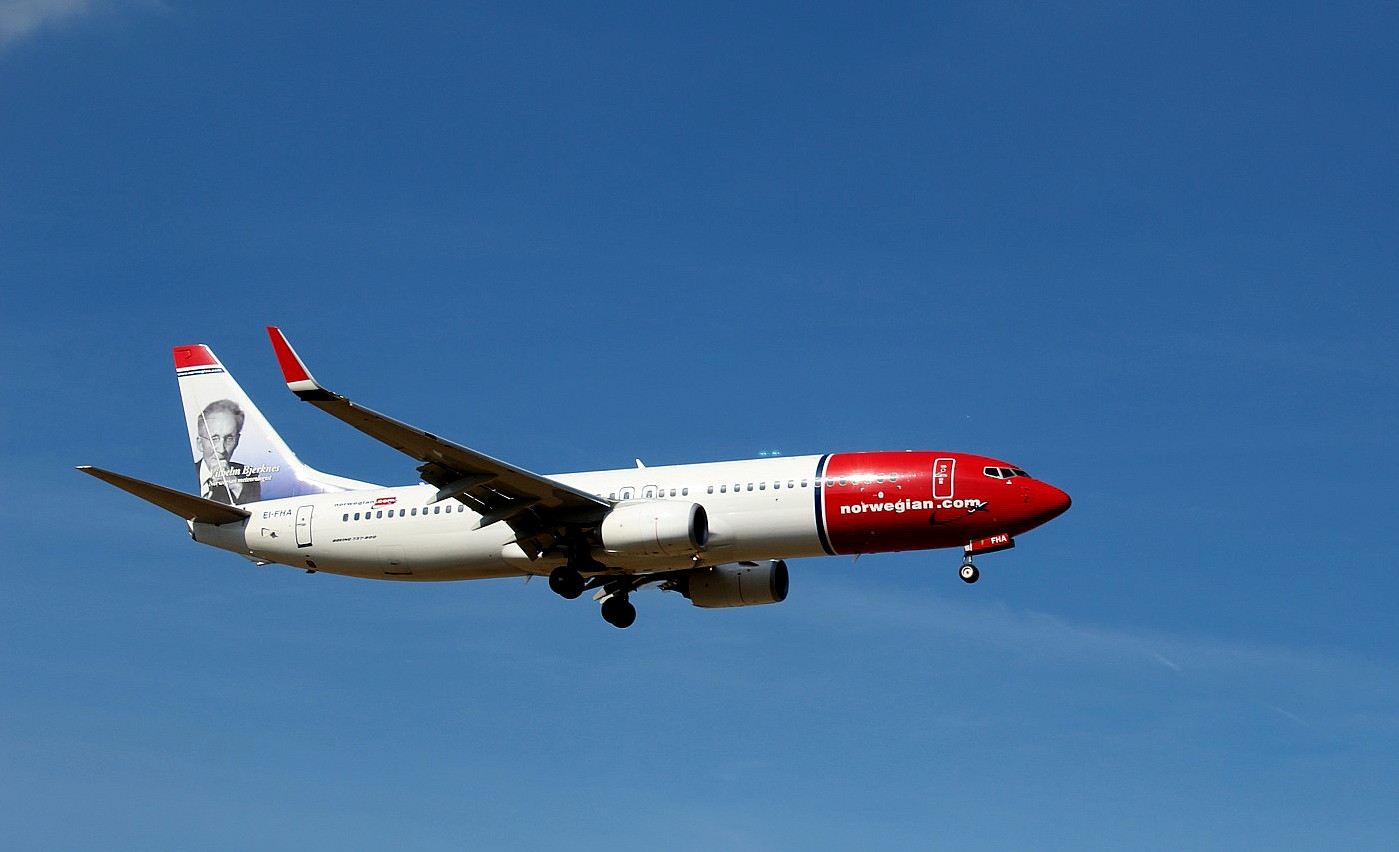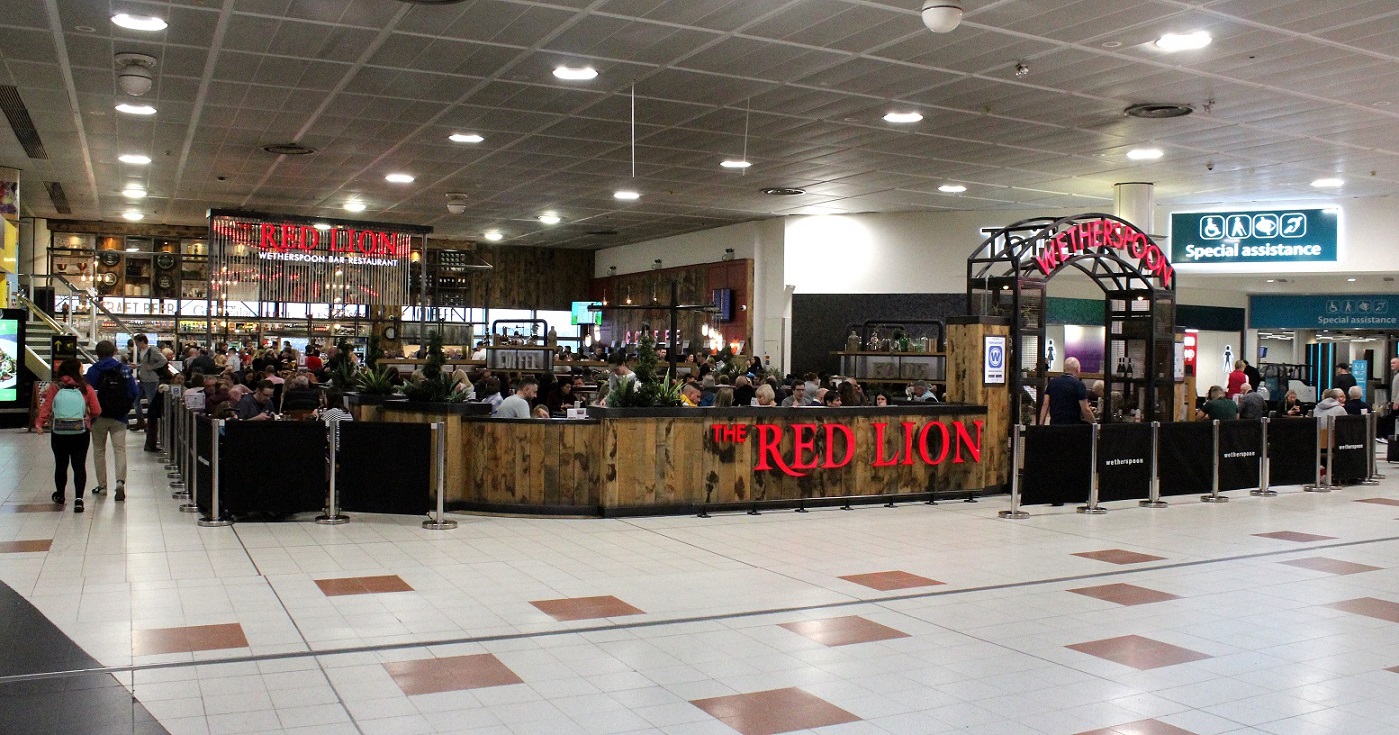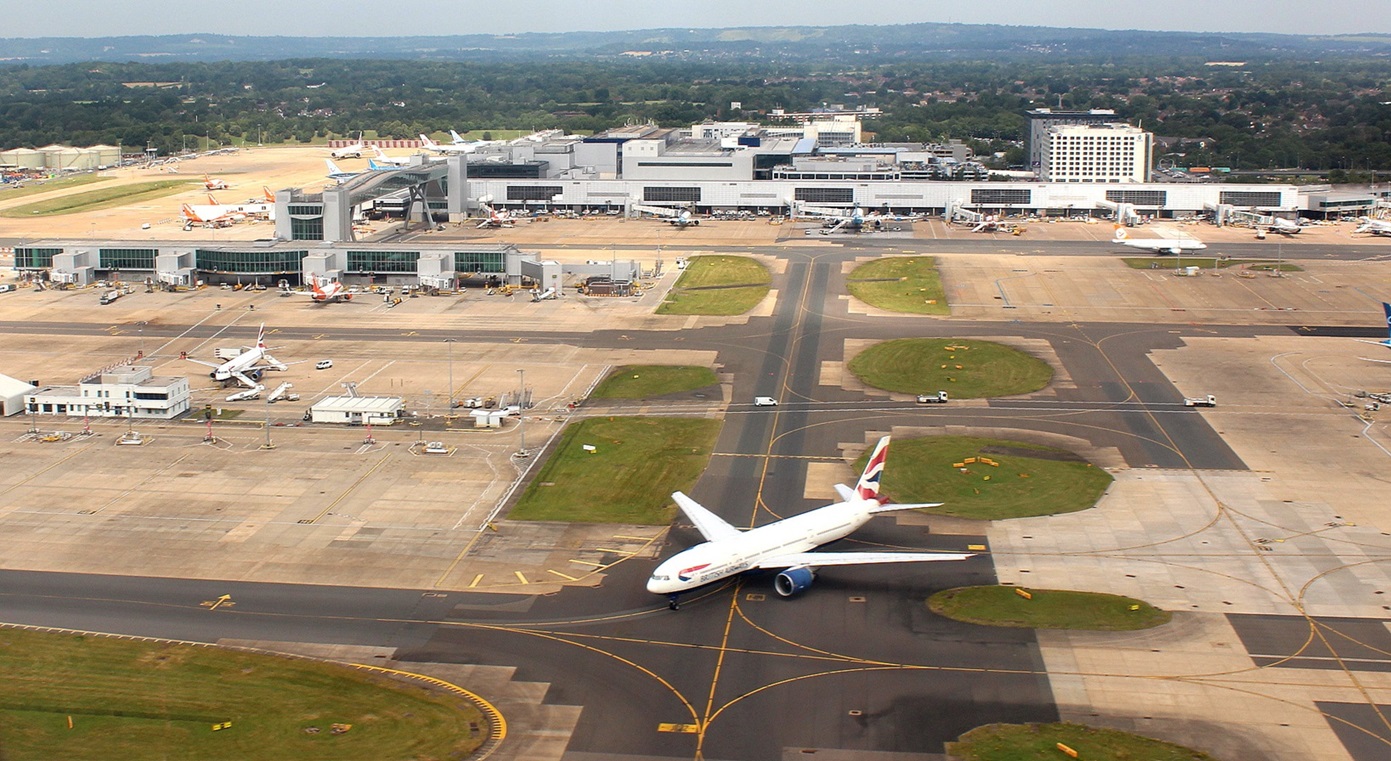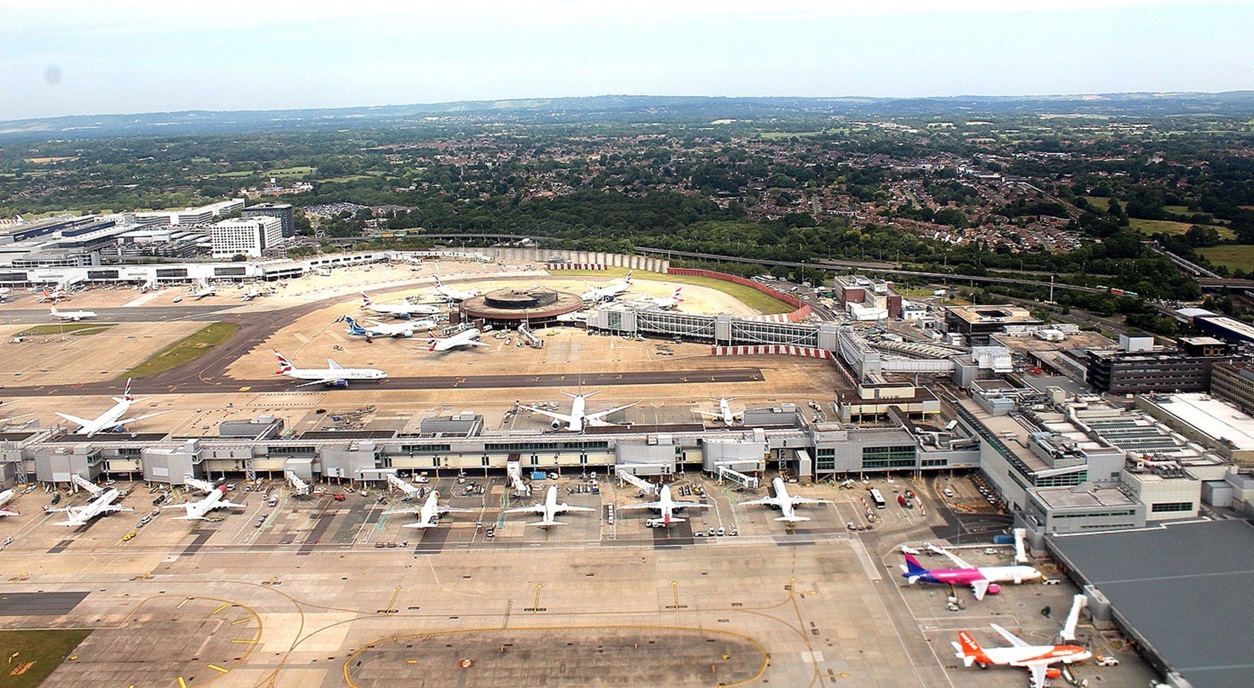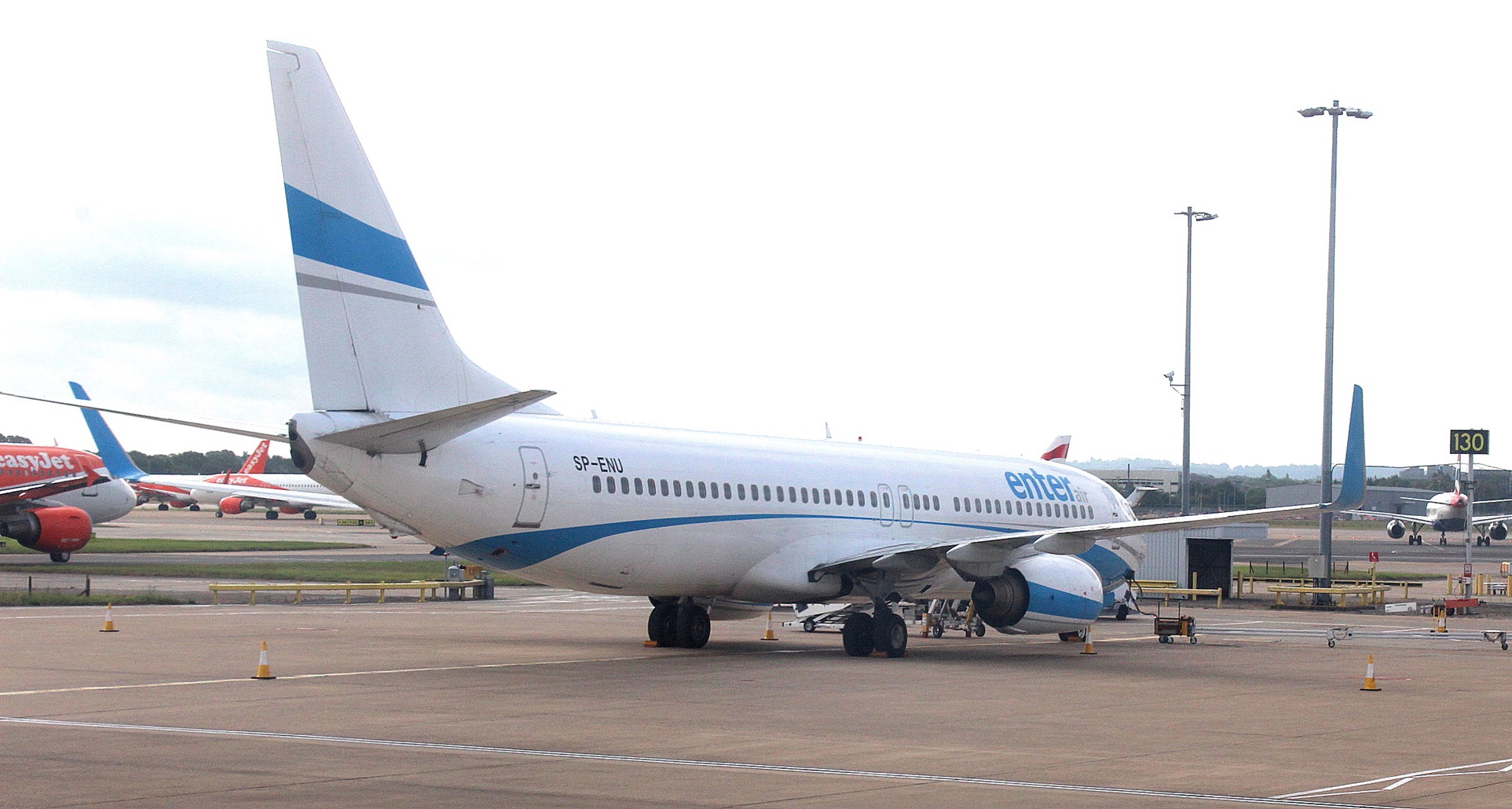Gatwick
GATWICK:
Originally a small private aerodrome to serve the racecourse. (Aka LOWFIELD HEATH)
Note: Also the base for the Surrey Aero Club.
Notes: In January 2021 Mike Holder, a great friend of this 'Guide' very kindly provided this map and the three photographs. The 1933 picture was taken looking north when GATWICK was just a small privately owned aerodrome. The third picture is a view looking south in 1937 and the fourth picture is taken looking north in 1937. I think the aircraft outside the British Airways hangar might well be a Fokker F.XIII, a type operated by British Airways - which of course has no relationship with the much later British Airways - when BEA and BOAC were merged in the 1970s.
One expert it seems reckons that the aircraft that can be seen taxying in from the landing area, in the fourth picture, is the Saro A19 Cloud G-ABHG. If this is correct it raises a couple of questions as it was registered to Osmond Spencer Baker with a central London address but listed a being based in Cowes on the Isle of Wight. With the Cloud having a crew of two, and carrying eight passengers, it would seem that Mr Baker was involved in an airline service from GATWICK to COWES?
A BIG BONUS PICTURE
Mike Holder also sent me this very rare picture of military aircraft that were flown in for being mostly scrapped? Or were they? I suspect that a company such as Airwork (?), having taken over the British Airways hangars, might well have been refurbishing many of them, (making one good aircraft from three or more), for selling on to developing air forces around the world. If anybody can kindly offer advice, this will be much appreciated.
Opened in 1935 as a regional airport. In WW2 a military aerodrome and afterwards reverted to being a regional airport. Now and for many years, a major LONDON international airport re-opening in June 1958 on a site further north.
Note: This picture (2013) was obtained from Google Earth ©
ICAO code: EGKK IATA code: LGW
GATWICK PICTURES
Note: All pictures by the author unless specified.
Military users: WW2: RAF Fighter Command 11 Group
141 Sqdn (Boulton-Paul Defiants)
Forward Airfield (Prior to D-Day)
141 Sqdn (Bristol Beaufighters)
309 (Polish) Sqdn (North American P-51 Mustangs)
RAF Bomber Command? I now believe 18 Sqdn (Blenheims) had a temporary posting here during 1939/40 and the failed operation in France which culminated in the evacuation from Dunkerque, (Dunkirk)
RAF Coastal Command
98 Sqdn (Fairey Battles?)
1028 Servicing Wing HQ
70 Group
287 (AAC) Sqdn (Hawker Tempests / Vickers-Supermarine Spitfires / Airspeed Oxfords)
Operated by: 1965: Ministry of Aviation
1990/2000: Gatwick. Airport Ltd
British airline users: Pre 1940: British Airways (About five months only) Hillman’s Airways*. Allied British Airways, Railway Air Services, Spartan Air Lines* and United Airways* too?
*When British Airways moved from HESTON in May 1936, Hillman’s Airways, Spartan Air Lines and United Airways had already been amalgamated into British Airways.
Post 1945: Air 2000 Airlines (Elite), Air Enterprises, Air Southwest, Airtours International, Air transat, Air UK, Air World (Envoy), Airwork, All Leisure Aviation, Astreaus, Aurigny Air Services, Aviation Beauport (Beaupair), Britair, Britannia Airways, British Airways (BA),British Caledonian Airways, British Island Airways, British Midland International, British United Airways, British World Airlines, Brymon Airways, Cal-Air International, Caledonian Airways, Channel Express.
CityFlyer Express, Community Express, Cunard Eagle, Dan-Air,Derby Airways, Donaldson International, easyJet, European Aviation Air Charter (Eurocharter), First Choice, Flightline, Flybe, G.B. Airways, Gill Aviation, Interline, Jersey Airlines, Jersey European Airways, Jet2com, JMC, Laker Airways, Leisure International Airways, Manx Airlines, Monarch Airlines, Morton Air Services, My Travel, Nationwide, Norse, Orient Air, Pegasus Airlines, Saga Airlines, Thomas Cook Airlines, Thompson fly, Titan Airways, Transair, Virgin Atlantic Airlines, Virgin Sun, Westward Airways, XL.
Note: A few of these airlines used GATWICK before it reopened in 1958.
It appears probable that the British 'Transair' name was kept on by Airwork after they acquired the company, then based at CROYDON, until 1957? In 1960 Transair was absorbed into BUA - British United Airways.
Note: The first picture is a scan from a postcard, simply captioned 'Gatwick Airport'. A bit of research found two more pictures of a Transair DC-7C at GATWICK, each dated 1966, so it seems reasonable to suppose that this picture also dates from that period. It appears that Transair had its roots in 1947 and grew to be Canada's fourth largest airline by 1973. However, the airline didn't start international operations until 1965 and ceased operations not so long afterwards in 1979.
Foreign airline users: Post 1945: Adria Airways, Aer Lingus, Aeroflot, Afriqiyah Airways, Air Algeria, Air Asia X, Air Atlanta, Air Baltic, Air Club International, Air Europa, Air Liberte Tunisie, Air Malta, Air Moldovas, Air Operations of Europe (AIROPS), Air Peace, Air Transat, ASA, Air Zimbabwe, Alitalia, American Airlines, American Trans Air (AMTRANS), Arkia Isreali Inland Airlines, Avia Airlines, Azalavia-Azerbalian Hava Yollari (Azal), Balkan-Bulgarian Airlines, BH Air, Base Regional Airlines (Coastrider), Belarus Avia, Belavia Belarussian Airlines, Braathens S.A.F.E. Air Transport, Bulgaria Air,
Cameroon Airlines, Canadian Pacific Airlines, Centennial Airlines (Cannon), Cimber Sterling, Continental Airlines, Croatia Airlines, Cubana, Cyprus Airways, Delta Airlines, easyJet Swiss, El Al Isreali Airlines, Emirates Airlines, Enter Air, Estonian Air, Eurocypria Airlines, European Air Transport (Eurotrans), Eurowings, Eva Airways, Finnair,
Futura, Garuda, Iberia, Hellenic Imperial Airways, Hong Kong Airlines, Iceland Express, Intersun, Istanbul Airlines, Jaro International, jetBlue, Lauda Air, Lufthansa, Maersk Air, Meridiana, Montenegro Airlines, Norse, Norwegian, Northwest Airlines, Olympic, Onur Air Tasimalicilik, Qatar, Rossiya Russian Airlines, Royal Jordanian Airlines, Ryanair, SAS Norway, SATA International, Sky Express, Strategic Airlines, TAP Air Portugal, Transair, Transavia, Tunisair, United Airways – Bangladesh, U S Airways, Viking
Military users: Post 1945: United States Army, United States Air Force, United States Navy (Communications types)
Note: These two pictures were kindly sent by Jim Eley in July 2019, and he used to fly them, after a career starting in the RAF at the end of WW2 flying Avro Lancasters.
First picture: This Canadair CL-44D started life with Seaboard & Western in the USA as N128SW. The design being based on the Bristol 175 Britannia. It was intially registered to Transglobe Airways from the 10th April 1968 until the 19th December 1968 when the operation became Tradewinds Airways who operated 'Golf Tango' from the 6th February 1969 until the 8th June 1979. Jim does not know where these pictures were taken - any ideas?
Second picture: Probably taken at Frankfurt in Germany (?), this Transglobe Airways Canadair CL-44D was also ex-Seaboard & Western, initially registered as N229SW. It was intended for export it appears, but the deal fell through and it was re-registered as N429SW. It only operated with Transglobe Airways from the 21st August 1968 until the 19th December 1968. It appears it may have gone back to the USA for a couple of years?
Tradewinds Airways acquired 'Oscar Victor' on the 13th February 1970 and operated it until the 15th December 1977. It was then sold to Switzerland as HB-IEO. What I find interesting is that I have no recollection of GATWICK ever being a major air cargo terminal, so I suspect Tradewinds operated far and wide.
Charter/air taxi: Pre 1939: Air Touring, Dominion Aircraft
Post 1945: ACE Freighters, Air Enterprises, Air Charter, Aviation Charter Enterprises, Air Condor, Air Couriers, Air Ferry, Air Freight. Air Gregory, Air International Charters, Air Links, Air London, Air Pegasus, Air Safaris, Airwork, B.E.A. Airtours, Bond Air Services, Britannia Airways, British Airtours, British Caledonian Airways, British Midland Airways, British Westpoint Airlines, Business Flights, Caledonian Airways, Cardinal Airways, Channel Air Services, Channel Airways, Ciro’s Aviation, DAS Air Cargo?, Derby Airways, Donaldson International Airways, Eros Airlines (UK), Hornton Airways, Hunting Air Travel, Irelfly, Monarch, Overseas Aviation, Steam Chicken Line, Tradewinds Airways, Transglobe
Car ferry: Post 1945: British United Air Ferries
Flying schools: Pre 1940: British Air Transport, Redwing Flying School, Surrey Aero Club
Post 1945: Air London
Helicopter hire/charter: Helicopter Services Ltd
In the 1957 The Aeroplane directory, Helicopter Services offered a fleet of four Bell 47Gs.
Helipad: 1998, ‘H’ at junction of taxiways 4 & 8
Maintenance: Post 1945: Air Couriers, Aviation Traders Engineering, B.E.A. Airtours, British Airtours, British Caledonian Airways
Manufacturing: Pre 1940: Airwork, Air Travel
Pleasure flights: Pre 1940: Air Travel, Home Counties Aircraft Services, Surrey Aero Club
A MIKE CHARLTON GALLERY
These pictures from postcards were kindly sent by Mike Charlton who has an amazing collection. See, www.aviationpostcard.co.uk
Notes: First picture: The British Airways DH86B Express was registered to British Airways, (no connection to BA today), from the 21st May 1936. Then, from the 13th December 1937 it was registered to West Coast Air Services, CROYDON, until the 22nd of October 1946. Thereby appearing to prove, as another of many examples, that several aircraft were employed in civilian duties during WW2. Mostly as airliners, regional and long haul.
Sixth and seventh pictures: Without much doubt, two pictures taken on the same sortie to photograph Gatwick from the air. I could well be mistaken of course, but these five 'Daks' and a Viscount all look to me like BEA (British European Airways) examples. I wonder which destinations they were serving? Channel Islands almost certainly, but presumably further afield? Note the aircraft on the GA (General Aviation) apron.
Ninth picture: This is just as I remembered GATWICK, pedalling down from LAP (London Airport). Always a treat; note the five light aircraft on the GA apron which invariably gave us 'spotty' spotters a rare view of an unusual visitor from an exotic country such as Germany or even Switzerland! Those were the days.
Location: Roughly 2nm WSW of junction 9 (M.23), just W of the A23, about 6nm S of Redhill town centre and about 3nm N of Crawley town centre
Period of operation: 1930 to 1935 (closed for drainage work, construction of new terminal etc)
1935 to 1952 (closed 1952 to 1958 for major redevelopment)
1958 to -
Runway(s): 1933: Max landing run: 1189 grass
1937: SE/NW 1189 grass SW/NE 860 grass
WW2: Records seem to show conflicting evidence as to the nature of the runway surfaces during WW2. My best bet to date is that: 05/23 1280 was grass, as was 09/27 1097 mtrs.
There was also a grass runway NW/SE 914 on steel matting
1959: 08/26 2134x46 hard
1965: 09/27 2134x46 hard
1990: 08R/26L 3159x46 hard 08L/26R 2565x45 hard
Note: These maps are reproduced with the kind permission of Pooleys Flight Equipment Ltd. Copyright Robert Pooley 2014.
THE GATWICK AIR STATION 1965
The detail map above shows the Gatwick Air Station, adjacent to the old 'Beehive' terminal, and operated by BEA Helicopters.
The grass manoeuvring area shown measured: N/S 152 E/W 145
LATER RUNWAY INFO
2001: 08R/26L 3316x46 hard 08L/26R 2565x45 hard
NOTES: I’ll quote this, (and other items), from the Gatwick Aviation Society web site simply because it does serve to illustrate how many British airfield names go way back into our history. To quote, “The name Gatwick can be dated back to 1241, when Richard de Warwick assigned his rights to some land in the manor of Charlwood (four acres of meadow and 18 acres of land) to John de Gatwick and his heirs. The land was part of what was later known as the Manor of Gatwick and was owned by the de Gatwicks until the 14th century when it passed to various different families.” In 1890 Gatwick was purchased by the Gatwick Race Course Company, opening in 1891 complete with its own railway station. So, a railway station at Gatwick preceded the airport by over forty five years.
THE BEGINNINGS: Late 1920s & early 30s
Dominion Aircraft Ltd based its Avro 504 G-AACX at GATWICK from November 1928. But GATWICK ‘airport’ only opened as a licensed airfield operated by Mr Ronald Waters from the 1st August 1930. Mr Waters also ran the Surrey Aero Club and pleasure flights using an Avro 504 commenced immediately. The Surrey Aero Club prospered soon adding an Avro Avian and a DH Gipsy Moth. The aerodrome also became popular with an increasing number of jockeys and racegoers arriving by air.
In 1932 GATWICK was sold to the Redwing Company owned by Mr F Bezner who, as head of the Redwing manufacturing company, making a side-by-side two-seater aircraft, decided to move the Redwing Flying School here to join the Surrey Aero Club. It is said that for a time they tried to call the airfield Redwing Airport but couldn’t make the name stick.
In British Built Aircraft Vol.3 Ron Smith says that between 1932/33 Air Travel Ltd converted at least three Avro 504N, G-ACLV, G-ACOD and G-ACOM after having moved from PENSHURST (KENT). They were also engaged in overhaul and refurbishment of Avro 504 variants and it appears they operated some of these for joy-riding operations. It would be interesting to discover all the venues used by this company. He also mentions that Airwork had an approved overhaul facility here for Armstrong Whitworth Whitley bombers from 1938.
THE AIRPORT CONCEPT
It was in 1933 that Morris Jackaman bought GATWICK for £13,500 and in 1934 formed Airports Ltd. There is a record of Avro Avian G-EBXO being operated from GATWICK by Sydney H Holland in February 1933. The 1933 itinerary for Alan Cobham’s UK No.1 Tour for 19th April is Gatwick Aerodrome, Horley. The town of Horley today, (and possibly then?), is in Surrey of course but the GATWICK site seems to have been, even then, in Sussex? A good demonstration of the difficulty I have often had in assigning exact locations to various Counties.
It was in 1934 that Airports Limited were issued with an Air Ministry public license allowing the ‘airport’ to be used by commercial aircraft…or airlines. In 1935 Mr Jackaman involved Marcel Desoutter, (the Desoutter name is also important in early British aviation history and his story is well worth ‘Googling’ up), as his business manager. They later became partners having interests in both GATWICK and GRAVESEND. Together they formulated plans for the entirely ‘world beating’ and innovative ‘Beehive Terminal’ which really did take the world by storm when it opened.
In the meantime in 1935, a new railway station was opened for GATWICK served by Southern Railways with two trains per hour on the Victoria to Brighton line. I now find this note I made interesting: “Hillman’s Airways were the first to operate out of GATWICK with services to BELFAST and Paris. Later they merged with United and Spartan Airways in 1935 to form Allied British Airways.” It now appears that the amalgamation took place on the 1st October 1935 and the new company was British Airways. The problem being that British Airways, then based at HESTON, allowed the companies taken over to continue operating using aircraft in their existing colour schemes. In July 1935 the ‘old’ GATWICK aerodrome was closed for construction of the new airport which opened in 1936.
A time-table illustrated by Neville Doyle in his book The Triple Alliance spanning May 25th to October 3rd 1936 clearly states “R.A.S. – SPARTAN – NOW IN ITS 4th YEAR OF OPERATION” . All rather confusing; ‘R.A.S’ is of course Railway Air Services and Spartan had been amalgamated into British Airways in 1935! Basically the service started at Victoria railway station, the first sector being by train to GATWICK. From GATWICK only RYDE and COWES were served. (By then airline services to BEMBRIDGE and SANDOWN had ceased). According to Neville Doyle the service was flown by the DH.84 Dragon G-ACNI, possibly also by another Dragon G-ACNG; “…but there were no Spartan services after 1936 and British Airways then became a completely Continental airline.”
Another time-table illustrated by Neville Doyle is the British Airways route schedule for 1936 showing the London–Paris service (GATWICK to LE BOURGET) and the London–Holland-Germany-Scandinavia service (Daily except Sundays). As per the PARIS service, and indeed the Isle-of-Wight service mentioned above, the initial embarking point was Victoria train station. It was a common practise in the 1930s for airlines to transport passengers from a city centre terminus to the airport, a practice that certainly continued in London. Indeed BEA (British European Airways) opened a terminus in the Cromwell Road to serve London Airport (now known as HEATHROW) in 1964. It was closed in the early 1980s.
The 1936 route was GATWICK to Amsterdam (Schiphol), Hamburg (Fuhlsbuttel), Copenhagen (Kastrup), Malmo (Bulltofta) and Stockholm (Bromma). Can you excuse a little boast? I have flown several times from Bromma in Swedish registered light aircraft, including at least three flights when checked out to be PIC (Pilot In Command) – without an instructor. The sheer privilege of being able to fly friends around central Stockholm at low level is something I will remember forever.
Another aspect of British Airways in 1936 was the acquisition of the Continental operations planned by Crilly Airways based at BRAUNSTONE airport in Leicester. Crilly had acquired four ex-KLM Fokker F.XIIs G-ADZH (ex PH-AFV), G-ADZI (ex PH-AFU), G-ADZJ(ex PH-DZJ) and G-ADZK (ex PH-AII). These aircraft were transferred to British Airways, with some appearing on the Paris service as early as March 1936. For quite a time I was at a loss to understand the general chaos existing in UK regional airways in the 1930s. Until I looked at the bigger picture and then realised this regional airline expansion was taking place during ‘The Great Slump’ or ‘General Depression’. The similarities between that period and the ‘so-called’ major banking collapse in 2009 are many. For example whilst some areas were decimated, others weren’t much affected and some even prospered.
Note: The second picture taken by the author in 2006 of the 'Beehive' is of its present location within the CAA facility situated in the industrial estate north of Crawley but south of the present day airport.
THE 'BEEHIVE'
In late 1936 the radical circular GATWICK ‘beehive’ terminal building was opened and it was sensational for the time in many respects. It was it seems the first of many ‘remote’ European airports with a direct railway link to the city centre, (London of course in this case). When opened it had the first ‘really practical’ electrically powered telescoping passageways, (invented in the USA and apparently the second airport in the world to have these), extending from the terminal building out to the airliners. An early form of the ‘jetway’ mobile pier so common at nearly all major airports in recent years. This said I have often been on flights to major airports and seen loads of empty ‘jetways’ available when taxying in only to be dumped onto a bus and then driven around the terminal. What is that all about? Costs charged probably I suppose? But then again, I wouldn’t be aware of incoming flights arriving shortly after with booked allocations to the jetways.
I was intrigued by the original architects drawings for the ‘Beehive’ terminal at GATWICK which referred to their design as being for the ‘London South (Gatwick) Airport Martello Air Station’. The term Martello being directly related to the numerous squat circular defensive forts erected in southern England and the Channel Islands during the Napoleonic wars. It seems that the original airport and WW2 aerodrome was located south of the now South Terminal complex but judging from the location of the ‘Beehive’ building the original airport must surely have been centred more to the S of the present airport as it’s now in the middle of a large industrial estate in north Crawley and S of the A23.
What really intrigues me seems to be the fact that a major feat of world-wide recognised architectural achievement in terms of airport terminal buildings was constructed on a nigh on useless airfield, let alone a practical airport. It is recorded that the ‘original British Airways’ company started operating here on the 17th May 1936 with the official opening of the airport occurring on the 6th June that year. It seems they gave up on trying to use this site, due to it being water-logged on the 7th Februrary 1937 and moved to CROYDON. (They moved again to HESTON in May 1938 albeit with the night mail flights to Germany still operating from CROYDON).
A STORY
A story which I think you’ll enjoy concerns the fate of the four Crilly Airways Fokker F.XIIs (G-ADZH, ZI, ZJ and ZK) told by Neville Doyle: “Whilst the Fokkers were used for a time by British Airways, on July 26th 1936 three of them arrived at Bordeaux, with the fourth on the following day, all on delivery flights to Lisbon, although Spain was their obvious destination. Both the French and British Governments had a Non-Intervention Policy prohibiting supplies to either side of the Spanish Civil War, but as the flight was to Portugal and the purchaser a Lisbon firm, it was classed as a commercial transaction and there was no objection from the British Government. When Pierre Cot, the pro-Republican French Air Minister, heard that four Fokkers were “going to the Facists”, he had them grounded but after some confusion, the British Government intervened and the Fokkers were allowed to fly back to Gatwick.”
So far so good but not particulary interesting, until: “Another offer was then received from Polish sources, ostensibly on behalf of a Katowice mining company. On August 12th, four Polish pilots turned up at Gatwick to collect the Fokkers. It emerged later that they were four fighter pilots, with no experience of large multi-engined airliners! They left the following morning and headed for France and then south towards Spain where storm clouds were massing over the Pyrenees.” I have had experience of flying in the Pyrenees when storm clouds are gathering and the last place you want to be in such circumstances, is airborne.
“Three turned back but G-ADZK crashed on La Rochelle-Lagord military airfield and became a total loss. G-ADZI arrived at Biarritz-Parme aerodrome (measuring some 400 x 600 metres) in a severe storm and tried to land. After the second abortive attempt, it climbed away and stalled as thunder rolled and lightning flashed around. It crashed to the ground and exploded. G-ADZJ, meanwhile, landed at Bordeaux, and was promptly detained for a second time, only to be released surreptitiously on September 6th by the pro-Nationalist city corporation and allowed to fly to Burgos. G-ADZH managed to cross the mountains and landed near Vitoria, from whence it was flown to Burgos by a Spanish pilot. These two surviving Fokkers were converted into bombers but later reverted to transport and training roles.”
I only mention this to express my delight, so very often, in exploring aviation history. Before embarking on research for this ‘Guide’ I had no idea, (or could have imagined), that GATWICK had such a direct link to the Spanish Civil War.
In March 2020 Mike Charlton very kindly sent me this picture from a postcard. Seen from a lay-by on the A23 looking south, it graphically illustrates just how small the new terminal was. But of course, in those days, a major airport development.
THE PROBLEM WITH GATWICK
Basically it appears the airfield was built to sub-standard specifications and/or “Jerry built” with the contractor using sub-standard methods and materials. Either way this airfield was not capable of functioning as an airport. It appears that most of the problems revolved around the British Airways operations especially with their Junkers Ju-52 types used on night mail duties which really ‘chewed up’ the soft grass runways. The night landing aids were reported as being totally inadequate and with exceptionally high rain-fall that winter the airfield was simply unable to cope. In other words yet another great English project defeated eventually by incompetence at most levels? Or, is this being too unkind? Some people with no idea of history like to construct the concept that these days the weather is behaving with violent consequences solely due to the interference of man-made intrusions. This might be the case, but the weather, if you study history, has always produced calamities, going back to the earliest records going back thousands of years. Oddly, and against nearly all 'expert' advice, all weather reports I have seen, made fifty or sixty years ago, exactly mirror those seen today.
A MAJOR AIR SHOW
It seems well worthwhile quoting from Graham Smiths excellent book Taking to the Skies when he reports that in 1938: “There was even more international flavour to the air display held at Gatwick, on 25th June. It was sponsored by the Daily Express, ‘…in recompense for the loss of the RAF Display’. Lord Beaverbrook, the newspaper’s proprietor, vowed it would be ‘the Display of the century.’ Certainly it attracted huge crowds and the large temporary grandstand, bedecked with Union Jacks, was full to capacity. German, French and American pilots competed and the RAF supplied formation teams of (Hawker) Harts and Furies. (Note: I have added the makers in brackets). Despite the fact they were billed as ‘secret War planes’ a (Westland) Lysander, (Fairey) Battle, (Bristol) Blenheim, (Hawker) Hurricane and (Armstrong Whitworth) Whitley were on show. The prototype Focke-Wulf Fw.200 Condor, Lufthansa’s latest sleek airliner, made its first appearance in Britain. The Display ended with a bombing set-piece á la HENDON and finally RAF Battles wrote Buy the Daily Express in smoke across the sky.”
If, when cycling down to GATWICK on a ‘reggy spotting’ sortie in about 1961/2, somebody had told me about this happening here……would I have believed the story?
WW2 NOTE
In late 1944 some 910 RAF personnel served here including 212 WAAFs.
In the years immediately after WW2, (possibly during or even before?), the Ministry of Civil Aviation, (later to become the CAA or Civil Aviation Authority), had a base here and still do for that matter. The point that intrigued me though was that just after WW2 they had their own small fleet of aircraft…an Auster, Proctor and Anson XIX. Do the CAA still have their own aircraft to use….and if not when was the ‘fleet’ disbanded?
FLEDGLING AIRLINES
It is impossible to ignore in UK aviation history, and after WW2 ended, the influence and impetus of countless RAF aircrew still wanting a career in aviation, and so many fledgling airlines being formed mainly managed and flown by ex-RAF personnel. To undertake any sort of work available, accepting the inherent peacetime dangers of commercial flying at that time…and there were many. It is also important to remember that the majority of British aircrew, once the war ended, deliberately walked away from aviation. And who can blame them? I suspect, (but can’t prove it), that probably Hornton Airways was a typical case? Formed in 1946, (probably with just one DH89A Dragon Rapide G-AIVO?) based at GATWICK ad-hoc charters were the mainstay of the business. In 1948 a single Douglas C-47 Dakota 3 (G-AKLL), was acquired to also undertake both passenger and freight charters. Quite typical of the time, seats in for one job, seats out for the next.
I suppose taking part in the Berlin Airlift between September and November 1948 with their ‘Dak’, (with 180 sorties being completed), was a windfall opportunity for this company? Also typical of the imaginative trading opportunities many such companies pursued, was that quite possibly the company over-extended itself – taking on too many commitments? For example, the company gained a license to undertake charter flights from Nicosia serving Africa, Europe and the Middle East. They also linked up with White Star Continental Tours who had a fleet of thirty coaches ready to serve air-coach tours to Czechoslovakia, (the ‘Cold War’ had yet to kick in?), the south of France and Switzerland.
And, all with one Rapide and ‘Dak’? Obviously a success in trading terms I suspect the company had no serious financial backing to expand their operations? Or perhaps the contract terms didn’t make a viable long term proposition? Who now knows? However, and for whatever reasons, the company was run down and ceased trading in May 1950.
GATWICK AIR SHOWS
Reading On Home-Made Wings by Arthur Ord-Hume can be highly recommended for all kinds of reasons, but his description of the air show, the Daily Express Air Rally held at GATWICK on the 10th July 1948, surely takes some beating? Amongst many quite extraordinary displays it appears the Fulton Airphibian car/plane NX60374 was demonstrated. I have seen a few pictures of it but would have bet a zillion pounds it had never ever flown in the UK before reading this account. In fact I still can’t quite believe it. But…I suppose I could say this about so many of the discoveries learnt about in researching this basic ‘Guide.’ Good job then, that I’m not at all interested in gambling.
The next year, on July 23rd 1949, the Daily Express hosted another air show, or “Air Pageant” at GATWICK. This time featuring the “smallest aeroplane in the world!” The Ken Coward Wee Bee, 15 feet long, with 18 feet 4 inches span, 3 feet 6 inches high and with the ‘pilot’ Karl Montijo lying prone on top of it! As Arthur Ord-Hume so eloquently describes this event, “With an empty weight of 170lbs, it flew around the aerodrome to the delight of thousands, its 30 bhp two-stroke engine sounding like a gnat farting in a cocoa-tin.”
THE FIRST INCLUSIVE TOURS
In 1949 a Russian émigré, Vladimir Raitz, formed Horizon Travel with an office in Fleet Street, London and set about offering the first Inclusive Tours (I.T.). In 1950 the first chartered Dakota, (which one?), departed from Gatwick with 32 passengers. After refuelling at Lyon they arrived at Calvi, Corsica, six hours later. The cost was £32.10.00d and they slept in ex US Army tents. By 1952 a Palma service had started followed by Lourdes in 1953 and the Costa Brava and Sardinia in 1954. By 1990 it is claimed that 21 million (British only?) people were having I.T. holidays. It is said that when Mr Raitz witnessed the appalling, unbridled and uncontrolled development of the Spanish coastline, for example, he was deeply unhappy. But by then of course he had little or no influence, the Inclusive Tour revolution was in full swing.
I just had to include this. In 1954 Channel Air Services were operating passenger charter flights from Gatwick with Avro Ansons. This is the aviation equivalent of getting a small box van truck, punching a few holes in the sides, nailing in a few deck chairs and calling it a coach service!
Note: The three pictures of airliners landing were taken in September 2015. However, the first picture of the Thompson 737 intrigues me as I do not think I had then seen a 737 with the extra 'winglets' slanted downwards. Can anybody say what model of 737 this is? The third picture of the Norwegian Air International 737-8JP is certainly a sign of the times as it was registered in the Irish Republic as EI-FHA. In recent years I have had the impression that over a quarter of all movements at Gatwick have been by EasyJet.
THE START OF GATWICK AS WE NOW KNOW IT
When GATWICK re-opened in June 1958 with an official ceremony on the 9th presided over by the then fairly new Queen Elizabeth. A Jersey Airlines DH.114 Heron was the first scheduled flight to arrive! Since then GATWICK has been probably been the largest UK airport served by independent airlines? In the development of holiday charter flights, and still is? A vast number of destinations have been served especially to Europe and much of the USA.
However, the future of Gatwick was far from decided in the early 1950s, the site had serious problems, (mainly flooding/drainage issues), and despite developments during WW2 and civilian use from 1946 to 1952 these had yet to be resolved. Incredibly GATWICK was chosen to be the No.2 London Airport from 50 other possible sites! But, the new airport had two advanced features. One was the ‘Finger Terminal’ involving a pier built out from the main building enabling passengers to walk out to their aircraft mostly under cover, the second being another ‘Finger’ of sorts connecting the main terminal to the main line London-Brighton railway. It was many years later before HEATHROW got it’s first rail connection to central London and that was a dismally fudged affair extending the Piccadilly Underground line.
In 1959 it appears that BEA were the main operator, hosting their Channel Islands flights and a Helicopter Unit. Another resident operator was Transair.
However, for me at least Morton Air Services will always be associated with GATWICK. In 1959 the all De Havilland fleet comprised:
De Havilland DH.89A Dragon Rapide G-AGUG, G-AGWP & G-ALBH
De Havilland DH.104 Dove G-AJBI, G-AJDP, G-AKJR, G-AMYO, G-ANAN & G-ANVC
De Havilland DH.114 Heron 1 G-AOXL (Non retractable undercarriage)
De Havilland DH.114 Heron 2 G-AOGO
By comparison, and I think an interesting comparion, the Transair fleet at that time was:
Douglas Dakota G-AMPZ, G-AMSV, G-AMZD, G-AMZF, G-AMZG, G-ANRA, G-ANTB & G-AOUD
Vickers 804 Viscount G-AOXU, G-AOXV & G-APKG
THE START OF LONG HAUL
In 1973 British Caledonian Airways, (who were based here), become the first British independent airline to operate scheduled services to New York. They were also the first British airline to operate into the newly opened Charles de Gaulle airport, (Paris), in 1974. GATWICK was also the base for Laker Airways, the first to pioneer “low cost” airline operations starting in 1966, across the Atlantic. Some forty years later the idea has really caught on but, taken to extremes, is it really worth saving a few quid to travel “prisoner of war” class in an aerial cattle truck with Wizzair for example? When you intend to enjoy going on holiday? (I have been told that Wizzair have since improved).
From 1974 to 1979 the Bell 206B G-AWGU operated by British European Airways was based here at the ‘Beehive’ doing a vast range of jobs. The quaintly named Steam Chicken Line air taxi operation, (1970s?), flew at least one BEAGLE B.206. That’s a name to conjure with, is anything more known?
GATWICK RE-INVENTS ITSELF AGAIN!
The third reincarnation of GATWICK occurred on the 9th June 1978 when yet again the ‘new’ airport was opened by Queen Elisabeth II. To coincide with this a scheduled helicopter ‘shuttle’ link to HEATHROW began. However, it appears this was not the first ‘shuttle’ link between the two airports. Westward Airways started a service on the 25th June 1969 using a Brittan-Norman Islander. This was involved in a accident along the way and it appears a Piper PA-28 Cherokee was hired in, (presumably a Cherokee 6?), this aircraft flying the last service on the 22nd August 1970.
The helicopter service starting in June 1978 was unusual in that the aircraft, Sikorsky S-61N G-LINK, was owned by the BAA but operated jointly by British Caledonian and British Airways Helicopters. Ten return flights a day were undertaken and it seems the service was highly profitable and popular, (which, excuse me for being cynical), might well explain why the government Minister responsible (Nicholas Ridley) cancelled permission to operate the service in 1986. He became part of the Conservative Thatcher cabinet which ruled from 1987.
Note: These four pictures were taken by the author in March 2020.
THE BAD OLD DAYS HAVE GONE
Despite often terrible problems in handling ‘high season’ demands, GATWICK at one time was becoming synonymous with nightmare delays for holidaymakers taking inclusive packages with ‘charter’ operators. This airport and the airlines have mostly overcome nearly all the set-backs and is now a shining example of a well run international airport. And, I say this as a frequent user in recent years.
A MOST EXTRAORDINARY SET OF CIRCUMSTANCES
Quite possibly the most extraordinary occurrence at GATWICK in recent years happened when virtually all commercial air services throughout Europe were cancelled when a volcano erupted in Iceland sending a vast cloud of ash in around June 2010. The Tiger Club at HEADCORN, (and many others of course), took advantage of this closure of strictly controlled airspace sending a veritable squadron of thirteen aircraft, including Stampes, Tiger Moths, Turbulents, a Cub and Midget Mustang to fly down the runway at GATWICK, orbit and make a second run. Plus of course, if the powers that be really are serious about controlling environmental pollution, the first thing they should do is putting a ban on these delinquent volcanoes erupting willy-nilly around the world. That one in Iceland made a complete fool of me by buying a car with a reduced pollution exhaust system fitted for the London ULEZ And, to think that I was convinced I was saving the planet - what a blow!
AND YET ANOTHER CATASTROPHE - THIS TIME A REALLY BIG ONE
In early 2020 the Corona virus global pandemic started taking hold. When my wife and I flew out of GATWICK in early March the place was heaving, and still very busy when we returned a few days later. By the end of the month the North Terminal was closed and easyJet had grounded their fleet.
BACK IN BUSINESS - AND HOW! JULY/AUGUST 2024
(Pictures by the author)
NORTH TERMINAL
APRON AIRLINER DETAILS 18th JULY
Photo One is the jetBlue Airbus A321-271NX, N4073J.Photo Two is the Air transat Airbus A321-271NX, C-GOIF. Photo Three is of the Norse Boeing 787-9 Dreamliner, G-CKWP.
GENERAL VIEWS
Tis always a problem for me, given a window seat and my trusty snapometer. I just love airports - dating back to being a lad living next the then called London Airport.
Now Heathrow of course, or as some of us prefer: Thiefrow. Often known for many years as the worlds largest building site - with its own airport! Mind you, Gatwick hasn't been too far behind in claiming that title to fame.
TAKE-OFF VIEWS, DEPARTING 18th JULY 2024
View Four: Taking off towards the east, our Westjet Boeing 737-800 series made a left turn, giving this overall view of Gatwick from around 10,000ft. I'm getting on a bit now, aged 76 at the time, and would never have believed that I would be flying across the Atlantic to Nova Scotia in Canada, in a Boeing 737. Once often boarded 737s for destinations in Europe.
A FEW MORE VIEWS
Note: View Five is of runway 08 Left, 26 Right. I wonder how often this runway is actually used?
ARRIVING, 6th AUGUST 2024
Note: Coming in to land provides much better opportunities for taking a few snaps. Altogether slower and lower.
For me the transformation of Gatwick over years has been astonishing. Can still remember, quite clearly, cycling down from our home near London Airport as a teenager in the summer holidays to see what was going on here. The light aircraft park north of the single terminal being of special interest.
As is sometimes said, these days nostalgia isn't what it once was. To see Gatwick today, (in 2024), I can only applaud the incredible transformation. But, this said, it does remind me of a very wise person pointing out that the best way to make a small fortune in aviation is to start off with a large fortune. As listed, the amount of different airlines operating from Gatwick surely bears testimony to how fickle the airline industry is. Or can be.
AND FINALLY, A FEW MORE AIRLINER PICTURES
Picture One is of the Air transat Airbus A330-343, C-GUBO. Picture Two shows the Enter Air Boeing 737-83N, SP-ENU from Poland. Picture Three is of the Norse Boeing 787-9 Dreamliner, (a type having had many problems along the way), G-CKWN. Last but certainly not least is Picture Four of the Boeing 777-312 of Air Peace, now registered as 5N-BWI in Nigeria. This airliner has had a rather chequered career being previously registerded as 9V-SYK in Singapore, EI-FMZ in Ireland and VP-BEK in Berrmuda.
Sandy Cotterman
This comment was written on: 2020-08-10 13:51:33I am doing research on one of the original co-directors, Charles Godsal (1907-1965), of Air Couriers LTD, and the sports car des designed and built in 1935, call The Godsal Chassis 001. The car was sold to a pilot working for Air Couriers mid-40's to early '50's. If any one is a descendant of this pilot or remembers hearing stories about a pilot and a sports car, or about Charles and his green parrot named Cat. Hook, please contact me at 2JagGirl@gmail.com
Graham
This comment was written on: 2021-02-09 18:21:12Hi, I'm trying to find information about the company Airbourne Aviation, which provided ground services for Dan Air at Gatwick in the 1960's. In particular I want to know about Henry Herbert Snowball, the company principal, who was also responsible for the Thames Ferry Hydrofoils and owned a hotel on the Isle of Wight. Any information will be gratefully received and possibly be used in my autobiography.
We'd love to hear from you, so please scroll down to leave a comment!
Leave a comment ...
Copyright (c) UK Airfield Guide
















